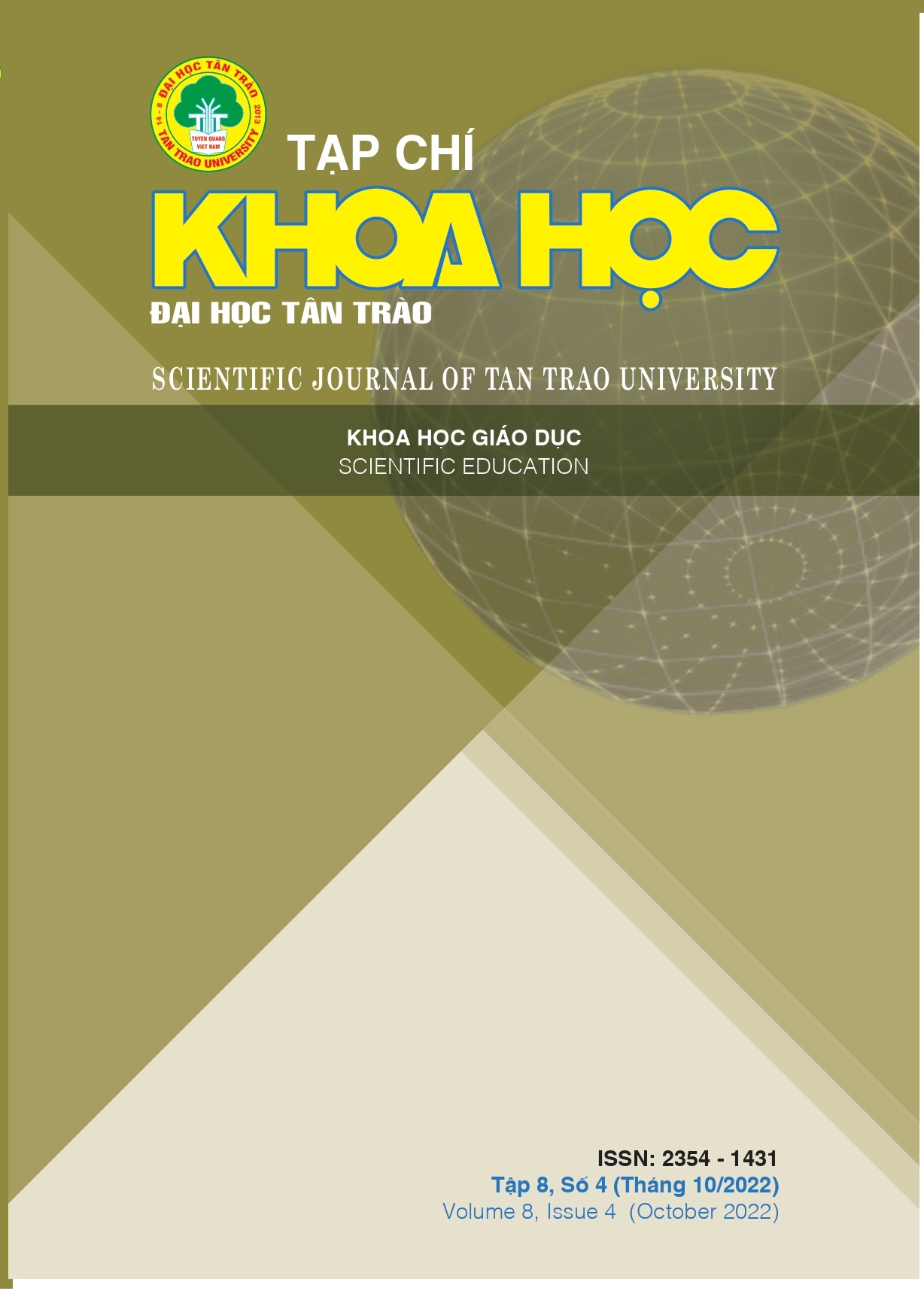ĐÁNH GIÁ QUAN ĐIỂM CỦA SINH VIÊN TIẾNG ANH PHÁP LÝ NĂM NHẤT VỀ CHIẾN LƯỢC NGHE THÔNG QUA MÔ HÌNH HỌC ĐẢO NGƯỢC
DOI:
https://doi.org/10.51453/2354-1431/2022/776Từ khóa:
Chiến lược; quá trình học; quan điểm; phương pháp học đảo ngược; cảm nhậnpháp học tập khác nhau và tập huấn cho giáo viênTóm tắt
Kỹ năng nghe đóng một vai trò quan trọng trong quá trình học tập của
sinh viên và trong giao tiếp. Với các chiến lược nghe hiệu quả, sinh viên
sẽ có cơ hội tốt hơn để cải thiện khả năng nghe hiểu của mình. Theo đó,
nghiên cứu này nhằm mục đích khám phá xu hướng của sinh viên năm
nhất chuyên ngành tiếng Anh pháp lý trong việc sử dụng các chiến lược
nghe, các vấn đề mà họ gặp phải trong quá trình này và cảm nhận của sinh
viên về việc thực hiện phương pháp học nghe thông qua mô hình học đảo
ngược. Bằng việc áp dụng phương pháp định lượng, bảng khảo sát câu hỏi
đã được thực hiện trong khoảng thời gian bảy ngày do sự bùng phát của
đại dịch Covid-19, khảo sát được thực hiện trực tuyến với sự tham gia của
77 người tham gia. Các phát hiện cho thấy rằng các chiến lược nghe được
sử dụng với tần suất cao bởi các sinh viên chuyên ngành tiếng Anh pháp lý
năm thứ nhất tại HLU. Hơn nữa, kết quả chỉ ra rằng sinh viên vẫn gặp khó
khăn khi áp dụng các chiến lược nghe và họ sẵn sàng học kỹ năng nghe
thông qua phương pháp học đảo ngược. Nghiên cứu minh họa xu hướng
và nhận thức của sinh viên chuyên ngành tiếng Anh của HLU về các chiến
lược học nghe tiếng Anh hiệu quả trong đại dịch Covid-19 tại HLU.
Tải xuống
Tài liệu tham khảo
[1]. Krashen, S. D., Terrell, T. D., Ehrman, M. E., & Herzog, M. (1984). A theoretical basis for teaching the receptive skills. Foreign Language Annals, 17(4), 261–275. https://doi.org/10.1111/j.1944-9720.1984. tb03226.x
[2]. Handayani, D. N. (2009). The problems of learning English at SMPN 9 Malang. [Unpublished thesis]. State University of Malang
[3]. Zappe, S., Leicht, R., Messner, J., Litzinger, T., & Lee, H. W. (2009). “Flipping” the classroom to explore active learning in a large undergraduate course. ASEE Annual Conference and Exposition, Conference Proceedings. https://peer.asee.org/flippingthe-classroom-to-explore- ctive-learning-in-a-largeundergraduate-course.pdf
[4]. Milman, N. B. (2012). The Flipped Classroom Strategy: What Is it and How Can it Best Be Used? Distance Learning, 9(3), 85-87. https://www.proquest. com/openview/616e91b3df376d82fd5d30c598c665f3/ 1?pq-origsite=gscholar%26cbl=29704
[5]. Bishop, J., & Verlager, M. A. (2013). The flipped class-room: a survey of the research. Paper presented at 120th ASEE Annual Conference & Exposition, Atlanta, USA. 23-26th June, 2013. http://www.asee.org/public/ conferences/20/papers/6219/view
[6]. The effect of flipped classroom strategy on listening comprehension of undergraduate students at English Department in IAIN Batusangkar. Advances in Social Science, Education and Humanities Research, 335, 316-321. https://doi.org/10.2991/ icesshum-19.2019.51
[7]. White, G. (2008). Teaching listening: Time for a change in methodology. In E. Usó-Juan & A. MartínezFlor (Ed.), Current Trends in the Development and Teaching of the four Language Skills (pp. 111-138). Berlin, New York: De Gruyter Mouton. https://doi. org/10.1515/9783110197778.2.111
[8]. Oxford, R., & Nyikos, M. (1989). Variables affecting choice of language learning strategies by university students. Modern Language Journal, 73(3), 291-300. https://doi.org/10.1111/j.1540-4781.1989. tb06367.x
[9]. Vandergrift, L., Goh, C., Mareschal, C., & Tafaghodtari, M. (2006). The Metacognitive Awareness Listening Questionnaire (MALQ): Development and Validation. Language Learning, 56, 431-462. http:// dx.doi.org/10.1111/j.1467-9922.2006.00373.x
[10]. Duy, V. H., & Quan, N. H. (2021). Vietnamese English-majored students’ use of listening strategies. European Journal of English Language Teaching, 6(6), 116-142. https://doi.org/10.46827/ejel. v6i6.3955
[11]. Nguyen, T. (2017). Implementation of English flipped classrooms: Students’ perceptions and teacher’s reflection. International Journal of Research Studies in Language Learning, 7(3), 87-108. https://doi. org/10.5861/ijrsll.2017.18763
Tải xuống
Đã Xuất bản
Cách trích dẫn
Số
Chuyên mục
Giấy phép

Tác phẩm này được cấp phép theo Giấy phép Quốc tế Creative Commons Attribution-ShareAlike 4.0 .
Bài báo được xuất bản ở Tạp chí Khoa học Đại học Tân Trào được cấp phép theo giấy phép Ghi công - Chia sẻ tương tự 4.0 Quốc tế (CC BY-SA). Theo đó, các tác giả khác có thể sao chép, chuyển đổi hay phân phối lại các bài báo này với mục đích hợp pháp trên mọi phương tiện, với điều kiện họ trích dẫn tác giả, Tạp chí Khoa học Đại học Tân Trào và đường link đến bản quyền; nêu rõ các thay đổi đã thực hiện và các nghiên cứu đăng lại được tiến hành theo cùng một bản quyền.
Bản quyền bài báo thuộc về các tác giả, không hạn chế số lượng. Tạp chí Khoa học Tân Trào được cấp giấy phép không độc quyền để xuất bản bài báo với tư cách nhà xuất bản nguồn, kèm theo quyền thương mại để in các bài báo cung cấp cho các thư viện và cá nhân.
Mặc dù các điều khoản của giấy phép CC BY-SA không dành cho các tác giả (với tư cách là người giữ bản quyền của bài báo, họ không bị hạn chế về quyền hạn), khi gửi bài tới Tạp chí Khoa học Đại học Tân Trào, tác giả cần đáp ứng quyền của độc giả, và cần cấp quyền cho bên thứ 3 sử dụng bài báo của họ trong phạm vi của giấy phép.






